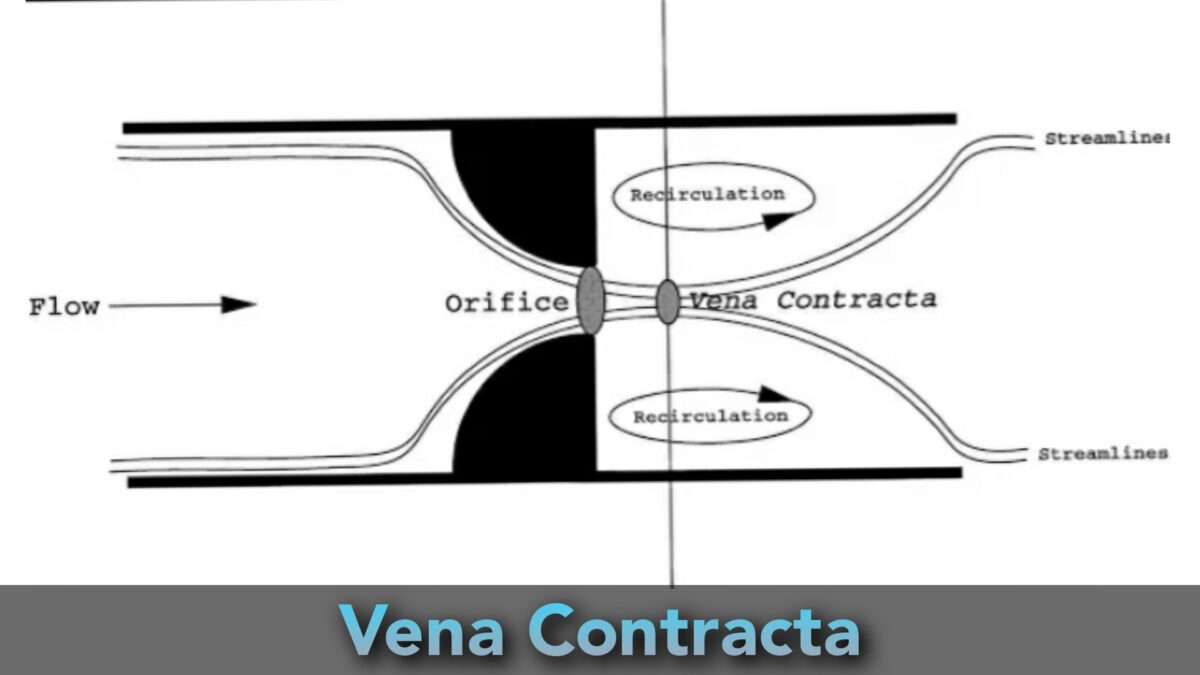Table of Contents
Definition
The vena contracta is a specific point in a fluid stream where the diameter of the stream reaches its smallest value, resulting in the highest fluid velocity. This occurrence is commonly observed when a fluid is discharged through a nozzle, orifice, or a sudden reduction in pipe diameter.
What Is Vena Contracta: Explanation
When a fluid passes through a narrow opening or experiences a sudden contraction, the flow lines of the fluid converge just after the diameter change, leading to the establishment of the vena contracta. At this point, the cross-sectional area of the fluid stream is minimized, while the fluid velocity reaches its maximum.

In some cases, such as the flow from a tank into a pipe or a sharp bend in a river, flow separation may occur at the vena contracta or slightly upstream of it. Flow separation refers to the detachment of fluid from the surface, resulting in the formation of eddies and turbulent flow. This phenomenon can disrupt the flow regime, causing pressure losses and other related effects.
Flow separation can iccur near the vena contracta or just upstream of it, the vena contracta itself represents the location where the fluid stream achieves its highest velocity and exhibits the smallest cross-sectional area. Flow separation typically occurs slightly downstream of the vena contracta, especially in regions with sharp corners or abrupt changes in diameter where the flow cannot transition smoothly.
Formula Of Vena Contracta
The formula for calculating the area of the vena contracta, denoted as Avc, is given by:
Avc = Cc * A
where Cc is the coefficient of contraction and A is the area of the orifice.
The coefficient of contraction, Cc, is defined as the ratio between the area of the jet at the vena contracta and the area of the orifice. It quantifies the effect of the vena contracta on the flow.
Cc = Area at vena contracta / Area of orifice
For a sharp orifice that is concentric with the flow channel, a typical value of the coefficient of contraction is 0.611. This value is commonly used as an approximation in fluid mechanics calculations.
The coefficient of contraction ranges between 0 and 1. A smaller value indicates a greater effect of the vena contracta on the flow. In other words, if the vena contracta occupies a significant portion of the orifice area, the coefficient of contraction will be smaller, implying that the narrowing of the flow is more pronounced.
Conclusion
Understanding the vena contracta and its associated formula is important in different engineering applications. It helps in predicting the behavior of fluid flow through orifices, nozzles, and other flow control devices. By considering the vena contracta, engineers can accurately determine factors such as velocity, pressure, and discharge in fluid systems.
Faqs
Fluid dynamics experts use the term “vena contracta” to refer to the narrowest point in a fluid stream that occurs downstream of a restriction or orifice. It signifies the point where the fluid flow velocity is at its maximum and the cross-sectional area is at its minimum.
Fluid flow measurements rely on the significance of the vena contracta. It enables accurate determination of the flow rate. By measuring the velocity at the vena contracta and knowing the cross-sectional area at that point, flow rate calculations can be made based on the principle of continuity.
The vena contracta and pressure drop in a fluid system are directly connected. When fluid flows through a restriction, the cross-sectional area decreases, causing an increase in velocity. According to the Bernoulli’s principle, this increase in velocity leads to a decrease in pressure. The pressure at the vena contracta is typically lower than the upstream pressure.
Several factors influence the size of the vena contracta in fluid flow. These factors include the shape and size of the restriction or orifice, the fluid properties (density and viscosity), the flow rate, and the Reynolds number. Higher flow rates and larger pressure differentials tend to result in larger vena contracta sizes.
Engineers extensively utilize the vena contracta in various engineering applications, particularly in the design and analysis of fluid flow systems. It plays a vital role in flow rate measurement, such as calibrating flow meters. Additionally, engineers employ it in the design of nozzles, valves, and other flow control devices to optimize performance and minimize pressure losses.
Read also: Orifice Meter
